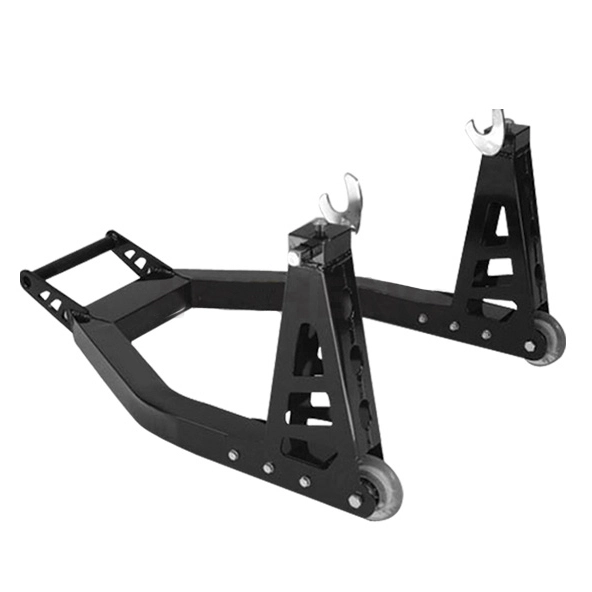Understanding the Basics of Motorcycle Paddock Stands
Types of Paddock Stands
Motorcycle paddock stands come in various designs, each tailored for specific purposes. Rear paddock stands are the most common, supporting the bike from the swingarm or spools. Front paddock stands lift the front wheel, often using fork sliders or headstock. Some versatile models work for both front and rear elevation. Triple tree stands, though less common for home use, offer stability for extensive front-end work.
Anatomy of a Quality Paddock Stand
A well-crafted motorcycle paddock stand boasts robust construction, typically utilizing high-grade steel or aluminum for durability and strength. Stable foundation, adjustable arms to fit different motorbike sizes, and scratch-proof non-slip rubber cushions are essential components. Quality stands feature smooth-rolling casters for effortless maneuvering and a reliable locking mechanism to ensure stability once the bike is elevated.
Selecting the Right Stand for Your Motorcycle
Choosing an appropriate paddock stand involves considering your motorcycle's weight, design, and intended use. Verify the stand's weight capacity exceeds your bike's mass. Ensure compatibility with your motorcycle's frame, particularly for rear stands that may require specific mounting points. For sport bikes, look for stands with adjustable width to accommodate varying swingarm designs. Anyone who owns more than one motorbike might benefit greatly from a multipurpose stand that comes with replaceable adapters.
Step-by-Step Guide to Using a Motorcycle Paddock Stand
Preparation and Safety Checks
Before utilizing your paddock stand, conduct a thorough inspection. Examine all components for signs of wear or damage. Verify that all bolts and fasteners are secure. Clear your work area of potential hazards and ensure you have ample space to maneuver. Don appropriate safety gear, including closed-toe shoes and work gloves. If possible, enlist a helper for additional support and safety.
Proper Positioning and Alignment
Position your motorcycle on a level, solid surface. For rear stands, align the support arms with the swingarm spools or designated lifting points. With front stands, center the support pads under the fork sliders or headstock. Adjust the stand's width if necessary to match your bike's dimensions. Ensure the stand is perpendicular to the motorcycle to maintain balance during lifting.
Lifting Technique and Stabilization
Grasp the paddock stand firmly and apply steady, even pressure to lift the motorcycle. Avoid jerky movements that could destabilize the bike. As you raise the stand, watch for any signs of imbalance or slippage. Once fully elevated, gently rock the motorcycle to confirm stability. Engage any locking mechanisms on the stand to prevent accidental lowering. Before proceeding with maintenance, double-check that the bike is secure and balanced on the stand.
Advanced Tips and Maintenance for Paddock Stand Users
Enhancing Stability and Safety
To further bolster stability, consider using wheel chocks in conjunction with your paddock stand. This dual-support system provides added security, especially during more intensive maintenance tasks. For long-term storage, place wooden blocks under the tires to alleviate pressure on the suspension. In garages with smooth floors, non-slip mats under the stand's feet can prevent unwanted movement. Always keep a watchful eye on your motorcycle's balance, particularly when working on components that might shift its center of gravity.
Maintenance and Care of Your Paddock Stand
Regular maintenance ensures the longevity and reliability of your paddock stand. Periodically inspect all welds, joints, and moving parts for signs of wear or corrosion. Lubricate pivot points and wheels with a suitable oil or grease to maintain smooth operation. Clean the stand after each use, paying special attention to removing any dirt or debris from the lifting mechanisms. Store your stand in a dry area to prevent rust formation. For stands with removable components, consider keeping spare parts on hand to address any unexpected issues promptly.
Troubleshooting Common Issues
Even with proper care, paddock stands may encounter problems. If you notice instability, check for bent components or worn rubber pads. Uneven lifting might indicate misalignment or a need for lubrication. Squeaking or grinding noises during operation often signal the need for maintenance of moving parts. For stands with locking mechanisms, ensure they engage fully to prevent accidental lowering. If you encounter persistent issues, consult the manufacturer's guidelines or seek professional assistance to maintain the safety and functionality of your paddock stand.
Conclusion
You should learn how to utilise a motorcycle paddock stand properly before hitting the road. You may greatly improve your skills in motorcycle maintenance by learning about the different kinds of stands, choosing the one that is best suited for your bike, and using it correctly. Remember, safety is paramount - always adhere to guidelines, perform regular checks, and maintain your stand diligently. An essential equipment for both minor and large repairs, your paddock stand will help you get the most out of your motorcycle and keep it running smoothly for years to come with some TLC.
Contact Us
For more information about our high-quality motorcycle paddock stands and other motorcycle maintenance tools, please contact us at info@runva.com.cn. Our team of experts is ready to assist you in finding the perfect solution for your motorcycle maintenance needs.

_1737625693698.webp)


